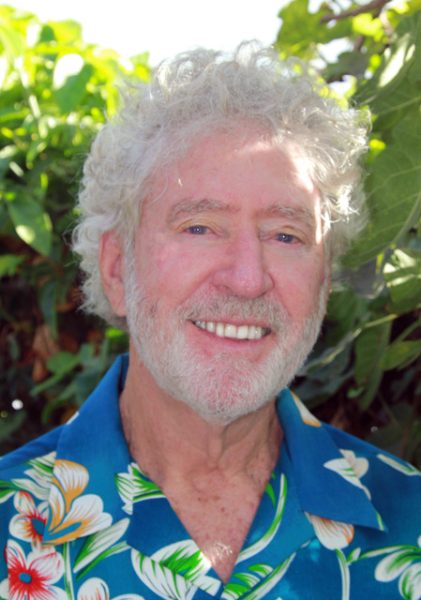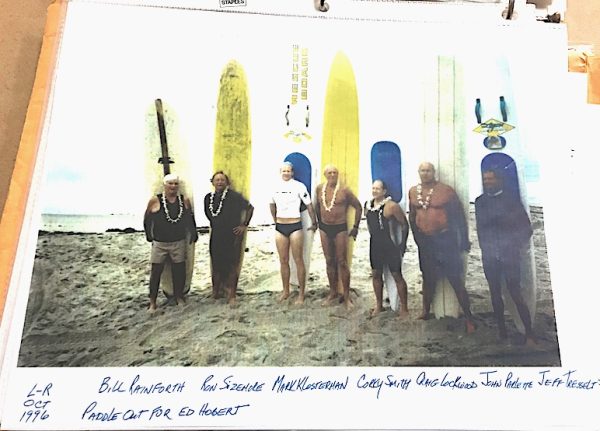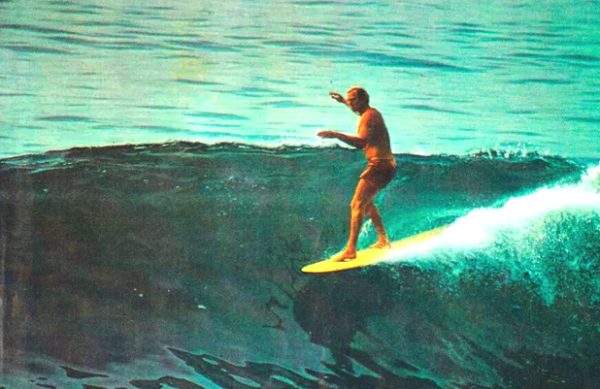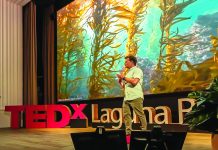 By Roger Butow
By Roger Butow
A June 1 paddle-out will be followed by a memorial service for Corky Smith, who was born on Oct. 30, 1935, and died at the age of 88 on Jan. 21, 2024.
The paddle-out at Brooks Street will be at 10 a.m. (arrive early), followed by service around noon at the Sandpiper Lounge, aka “The Dirty Bird.”
Family and friends will gather to catch up on each other’s lives. Tears of happiness, plus, yes, tears of sorrow and loss, will be shed.
The man and his dance partner literally ruled the Sandpiper dance floor for decades with spiffy moves. Always technically correct, he told me that his sophisticated mom insisted he learn professionally trained basics.
Brooks Street, as the home of our traditional locals contest, is a no-brainer; it’s adjacent to his favorite “lounging-lizard” rocks and sea wall at Oak Street.
By the way, this is where he and his bros, Tom Morey, Spider Wills, Ron Sizemore, Craig Lockwood, and John Parlette, held court.

A festive atmosphere and beach casual dress code will prevail. The ceremony revolves around the lives and legacies of the watermen and waterwomen who stood above the rest.
By participating in the water or on the beach, attendees publicly display reverence, pay last respects and utter a bookend goodbye. “Talk story” is integral in the remembrance and grief process.
The circle’s geometric shape is symbolic, representing how the infinite ocean is the common thread that binds, runs through us and around us, and both encompasses and connects our tribe’s members around the globe.
Typically, a paddle-out features a floating prayer circle composed of closest friends and relatives who form wearing Hawaiian “leis.” Here, memories are exchanged, and at times, the flowers themselves are spread as funeral wreaths.
“Much mahalos” to Chuck Harrell of the Sandpiper for opening early to provide a venue favorable to those who wish to share their favorite Corky tale via the stage microphone.
Despite their seemingly mythological origins, Paddle-outs aren’t really ancient Hawaiian rituals but relatively recent, 100-year-old phenomena.
The tradition began on Oahu when the Waikiki beach boys introduced it as a way of saying farewell in a joyous, not morbidly sad fashion.
As personal narratives about the deceased are offered, smiles, cheers, and the boisterous slapping or churning of the sea erupt, miming that person’s journey.
After all, life is not just one long, flat, featureless, placid lake without challenging ripples. Obviously, neither is the ocean, or we’d never have waves to ride.
Regardless, a paddle-out captures the essence of our core values, a lifestyle-affirming gesture that migrated to California in the late 1950s.
Just as we’re all one when in the water, the participants’ individual religious beliefs aren’t in conflict during the ceremony, all are harmonious.
If anything, a paddle-out provides for moments of silent reflection upon the very nature and meaning of life, plus our own inevitable mortality—not to mention what happens in between. Which is where each of our own unique stories reside, do they not?
By the way, “Talk story” is common to cultures worldwide. Whether they’re 100% factual accountings or not misses the point.
They’re intended to transmit, to pass down elements that elders deem important to provide continuity, cohesive ethical foundations and historical perspective to subsequent generations.
Early storytellers were often the tribal shaman, the group’s spiritual leadership. In India, the memorialization process before printing presses was made easier by using sing-song chants called “schlokas.”
In many such cultures, poetry with a musical beat or cadence was performed to help promulgators recall critical educational components.

I have no doubt that just as Corky was, like his close friend Dick Metz, a classic raconteur himself, there will be some tales told at both the paddle-out and Sandpiper service that feature exaggeration.
Our memories aren’t perfect, but it’s also true that demanding total “talk story” veracity isn’t mandatory. It doesn’t matter if the tales are imaginary or real: They can simply be intended as entertaining heritage adventures.
If you’ve never been to a paddle-out, you’re still welcome to come and observe the unusual way our water world reacts to death and experiences closure: One final “Aloha” and one last waltz at the Sandpiper.
Roger “Gonzo” Bütow is a prolific, often transgressive journalist and a 52-year resident of Laguna Beach. He’s co-founder and executive director of the unincorporated association known as Clean Water Now.
A retired general contractor, since 2010, he’s been a professional land use and regulatory compliance consultant, plus provided environmental and construction advisory services.
His contact information can be found at www.clean-water-now.org.





Comments by Jeff Tresselt, he’s the waterman on the far right in the foto from Ed Hobert’s Brooks Street paddle out nearly 30 years ago….thanks Jeff!
“The 70’s was a special time to be a kid growing up in Laguna. The summers were all about the beach. The beaches were delineated in name by the streets above them. Within each patch of coveted sand, rocks and surf spots thrived a unique ecosystem of characters inhabiting them.
For me, as a grom, the old guard legends of Oak Street seemed larger than life. The classic pink beach house (Oak Street) acted as a default HQ with the likes of Big John, Spider and Ron Sizemore holding court. Corky Smith was amongst this crew.
He was impossible to miss with his deep tan, chiseled waterman’s build, giant fu-manchu, faded speedo and signature headband. He always had time for me, often calling me over as I walked past to ask how I was doing and what I was up to.
Occasionally, he’d treat me to a combo plate at the back door (La Paz). Through the years we shared time in the sand, time in the water and walked a few trails in the canyon. I loved the stories he’d tell.
Corky was a tireless caretaker of the natural world around him and for the town that he loved. He’s an integral piece of the patch work fabric that is this place called Laguna Beach. He will be missed.
Ya’ta’hey and aloha my friend,
Jeff Tresselt”